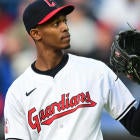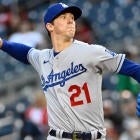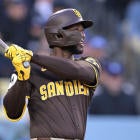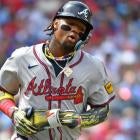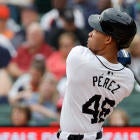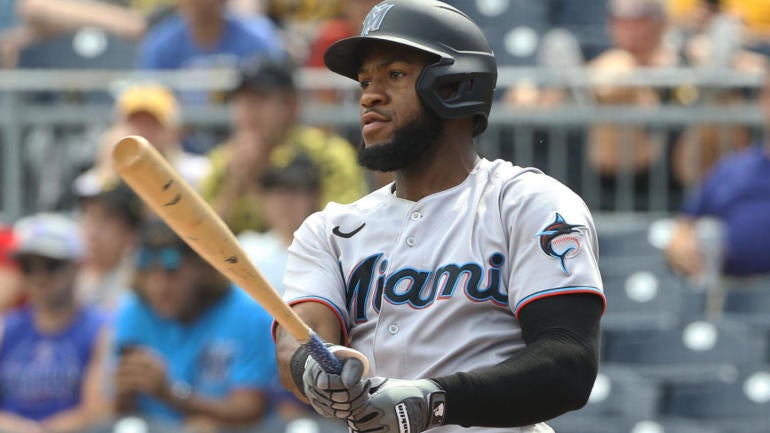
Done with Fantasy Football, are you? Think you can come crawling back to Papa Baseball, do you?
(Papa Baseball? Nobody calls me that.)
Well, where were you when I needed you last September -- or late August, even? Maybe you fell out of contention and lost interest. Maybe your league simply ended early. But the more likely case, I think, is that you were whooping it up with Daddy Football.
(Daddy Football? Nobody calls Dave Richard that.)
You know what? I'm a charitable guy. I'll overlook your wandering eye -- some might say enable it, even -- by catching you up on everything drowned out by that Siren's call of the fall.
Well, not everything. I had to take a hatchet to this article to bring it down to a reasonable length, and even saying that, the length is unreasonable.
Let's get to it.
Promotion palooza
Remember when September call-ups were a thing, back before service time manipulation entered our vernacular, compelling teams to hold back their best prospects until the following May? Well, September call-ups were back in greater numbers than ever last year thanks to draft pick incentives built into the new CBA.
You're probably wondering which prospects specifically got the call, and I'll answer thusly: all of them. It's only a mild exaggeration. Most everyone who we thought had a chance of coming up ultimately did, whether for 30 games or three.
All teams had to do to keep those draft pick incentives in play was not let their call-ups exhaust their rookie eligibility, and indeed, they were careful not to cross those critical thresholds. In general, you can expect the September call-ups to have the inside track on a starting job this spring. They have to be on the roster for the entire season to have a shot at scoring their team one of those coveted picks.
Here are some of the standouts, ordered roughly by how much I like them for 2023:
- Gunnar Henderson basically lived up to the hype and only firmed up his No. 1 overall prospect standing for this year.
- Corbin Carroll played only semi-regularly but was piling up extra-base hits by the end and will rate right up there with Henderson for 2023.
- Triston Casas struggled to adapt early but showed what makes him so special as a hitter over his final 13 games, batting .316 (12 for 38) with three homers and more walks (13) than strikeouts (11).
- Josh Jung's contact skills didn't translate right away, but the power did, putting him on the path to being the Rangers' starting third baseman this year.
- Ezequiel Tovar made the jump just a little after his 21st birthday and will have all the advantages of Coors Field if the Rockies turn the shortstop position over to him this spring.
- Oswald Peraza didn't end up overtaking Isiah Kiner-Falefa for the Yankees, but he made the most of his limited opportunities, flashing power and speed.
- Francisco Alvarez came up mostly to give the Mets a DH alternative against left-handed pitchers, but his arrival was also an early audition for the starting catcher role as a 21-year-old.
- Logan O'Hoppe doesn't have the defensive concerns of Alvarez and has more assuredly put himself in position to take over behind the plate this year.
- Miguel Vargas hardly played despite being one of the higher-profile call-ups. The Dodgers never once tried him at third base, which is a bit troubling, but hey, Justin Turner is in Boston now.
- Hunter Brown filled in for an injured Justin Verlander, showing good velocity with better-than-expected control, before transitioning to the bullpen.
- Drey Jameson had a 6.95 ERA at Triple-A Reno, a notoriously difficult place to pitch, but debuted with seven shutout innings against the Padres and ended up with a 1.48 ERA across four starts.
- Ryne Nelson's Triple-A struggles likewise didn't carry over to the big leagues. He began his career with a combined 13 scoreless innings against the Padres and Dodgers.
- Cody Morris was forced to stretch out at the big-league level after being injured most of the year, but he more than held his own with a 2.28 ERA.
- Hayden Wesneski, who joined the Cubs from the Yankees at the trade deadline, put together a 2.18 ERA and 0.94 WHIP over six appearances, four of them starts.
- Ken Waldichuk, a funky left-hander who came over in the Frankie Montas deal, offered a mixed bag over seven starts, but his last two were the best.
- Garrett Mitchell played only a platoon role for the Brewers down the stretch but flashed plenty of speed with eight steals in eight attempts. The strikeouts were alarmingly high, though.
- Bo Naylor was just an extra bat for the Guardians to end the year, but Mike Zunino is their best answer at catcher otherwise.
- Alec Burleson kept his batting average in the .330 range for basically the entire Triple-A season and didn't look overmatched in the majors even if he didn't have many hits to show for it.
- Kerry Carpenter enjoyed a power breakout in the minors, and the power eventually showed up in the majors, too, with four home runs in his final 14 games.
- Spencer Steer is a versatile infielder with the kind of pull tendencies that should lead to decent power production at a place like Great American Ball Park.
- Michael Toglia is an all-or-nothing-type hitter whose best hope for Fantasy relevance is the BABIP boost that comes from playing at Coors Field.
- Matt Wallner is a three-true-outcomes type who showed premium exit velocities in his 65 plate appearances but, fittingly, struggled with strikeouts.
- Jonathan Aranda is hit over power and may struggle to get in the lineup every day, especially as a left-handed hitter for the Rays.
- Miles Mastrobuoni is a Jake Cronenworth type, a real overachiever with enough steals potential to matter if he can find the playing time. He's since been traded to the Cubs.
- Jordan Groshans got a look at third base for Marlins but struggled to hit for power in the upper levels and may be better suited as a utility type.
Others who may surprise you
- Don't be too hard on yourself if you haven't heard of Joey Meneses. Nobody had before the Juan Soto trade created vacancies up and down the Nationals lineup. The 30-year-old was tasked with filling one, and it was the kind of performance that left you wondering why no one had given him a chance sooner. He hit .324 (72 for 22) with 13 homers and .930 OPS, striking out at a reasonable rate and generating premium exit velocities. Maybe he'll go the way of Frank Schwindel, but the skill indicators are stronger in Meneses' case.
- If you haven't heard of Meneses, it's possible you haven't heard of Jake McCarthy either. He wasn't a prospect of the stature of a Corbin Carroll or Alek Thomas in the Diamondbacks system but ended up overtaking the latter for regular playing time by season's end. From the start of his final big-league stint on July 11, he was the 11th-best outfielder in points leagues and the fourth-best in Rotisserie. His 19 steals over the final two months would have ranked 25th over the entire season.
- Back in April, when so many of the best hitters were unable to do anything with the humidified balls, you may remember that Taylor Ward out of nowhere became the world's best Fantasy pickup, batting .370 with a 1.194 OPS over his first 30 games. You may also remember that he faded just as quickly, batting .205 with a .601 OPS over his next 69 games. Well, guess what? Right about the time you tuned out, the good version showed up again, batting .353 with a .976 OPS in 36 games. His drop-off coincided with a shoulder injury that cost him a few games but never landed him on the IL, so I'm hopeful the good version is closer to the real one. Then again, this could be a fool-me-twice situation.
- Oneil Cruz's strikeout rate as a rookie was bad but not insurmountable given how hard he hits the ball. How hard is that? Well, his hardest-hit ball in 2022 was the hardest in Statcast history (122.4 mph). His September performance further demonstrates the point. He still struck out a discouraging 29.8 percent of the time but nonetheless hit .288 (34 for 118) with six homers, five steals and an .884 OPS. That'll play.
- The Reds' dynamic duo of Hunter Greene and Nick Lodolo had uneven rookie seasons, but both were locked in by the end. Lodolo had a 2.48 ERA, 0.88 WHIP and 12.1 K/9 over his final six starts, and Greene had a 0.62 ERA, 0.69 WHIP and 14.0 K/ 9 over his final five. The sky's the limit for these two.
- The Orioles traded their closer at the deadline and wound up with an upgrade. Felix Bautista embraced the role with 12 saves in the span of two months and an entrance that's pure theater, finishing with a 2.19 ERA, 0.93 WHIP and 12.1 K/9. Meanwhile, Jorge Lopez, who was having a breakthrough season, completely fell apart with a 4.37 ERA, 1.63 WHIP and 7.1 K/9 for his new team. No telling if the Twins stick with him.
- Tanner Scott's struggles allowed Dylan Floro to get another shot at closing, the role he was expected to fill at the start of the year before a rotator cuff injury changed those plans. He's no lockdown reliever, and a managerial change could render it all moot anyway, but he did fare well with a 1.46 ERA over his final 13 appearances.
- Other obscure relievers who could be favored to close at the start of 2023 based on the way last year ended include the Rays' Peter Fairbanks, the Reds' Alexis Diaz, the Rangers' Jose Leclerc, the Cubs' Brandon Hughes and the Angels' Jimmy Herget. The Cubs and Angels have since brought in Brad Boxberger and Carlos Estevez, respectively, which further obscures things.
- Depending on when exactly you tuned out, there's a chance you missed the entire Vaughn Grissom saga, beginning with him hitting .347 (33 for 95) with five homers and four steals in his first 26 games as a fill-in for Ozzie Albies and ending with him getting benched for Orlando Arcia during an 8-for-46 (.174) skid. It was a pretty quick hook for the 21-year-old with impressive minor-league credentials, but the Braves apparently weren't deterred. He's the heir apparent at shortstop now that Dansby Swanson is gone.
- Elvis Andrus found the fountain of youth after washing out in Oakland, of all places, batting .271 (49 for 181) with nine homers, 11 steals and a .773 OPS in 43 games as Tim Anderson's replacement for the White Sox. He was the third-best shortstop in points leagues and second-best in Rotisserie during that stretch. It was the first time he's been even remotely useful since 2019, and it may earn him a chance at a follow-up as he seeks a new team via free agency. Skepticism is warranted.
- Brayan Bello's major-league career got off to a particularly bumpy start, and the 4.71 ERA and 1.78 WHIP would suggest it didn't get much better from there. But it actually did. He had a 2.59 ERA over his final six appearances. You won't find many pitchers with both a ground-ball rate as high as 55.7 percent and a swinging-strike rate as high as 11.7 percent, the first of which would have ranked third among qualifiers. He still struggles to command the strike zone, but you can see a path forward here.
- As if the Braves didn't already strike it rich with Spencer Strider and Kyle Wright, Bryce Elder emerged as another quality arm for them down the stretch, delivering a 1.65 ERA, 0.92 WHIP and 9.1 K/9 in his final five starts. There were a couple of minor-league stints in between, and every one of those starts was against either the Marlins or the Nationals. He also doesn't have much swing-and-miss to his game, just a wicked sinker that piles up called strikes and ground balls. It's a tricky profile to assess, but he'll presumably have the inside track for the fifth starter job this spring.
- Bryan De La Cruz returned from the minors Sept. 7 with a shorter stride and a renewed focus on contact, and it led to him batting .388 (33 for 85) with six homers and a 1.137 OPS as the team's primary center fielder. He surged to the finish line in 2021, too, only to be pushed out by Jorge Soler and Avisail Garcia that offseason, but I suspect he'll get a longer look this time around.
- Orioles right-hander Kyle Bradish had four two-hit outings of seven innings or more over his final eight starts, compiling a 2.76 ERA, 1.01 WHIP and 7.5 K/9, but I'll admit I'm short on explanations as to why it happened. He did emphasize his slider over his fastball during that stretch, which may have helped, but the metrics are pretty blah overall. Then again, he also had a 1.30 ERA, 0.61 WHIP and 10.4 K/9 in six minor-league starts last year, so there may be something to it.
- Oswaldo Cabrera became more than just a platoon player after joining the Yankees in mid-August, ultimately stepping in as a full-time outfielder and hitting .304 (24 for 79) with six homers and a .984 OPS over his final 23 games. In 170 minor-league games over the past two seasons, he had 38 homers and 34 steals.
- David Villar got an extended look in the Giants lineup down the stretch, bouncing between third, second and first base, and showed he might have a future there with nine homers in 156 at-bats. Add that to his minor-league tally, and he finished with 36 home runs in 454 at-bats (though it's worth pointing out that the high strikeout rate and average exit velocity are both reason for skepticism).
Concerning developments
- Bryce Harper did make it back from a fractured thumb in late August, but you may remember he was also contending with a sprained UCL in his throwing elbow. Fair to say he wasn't quite himself after returning, batting .227 (29 for 128) with just three home runs in 35 games, and whenever there's UCL damage, Tommy John has to be in the discussion. He indeed underwent the procedure just before Thanksgiving and is out until midseason.
- If you get the sense Juan Soto is a Fantasy pariah all of a sudden, it's because things went from inexplicably bad to inexplicably worse for him after joining San Diego, where he hit just .236 with a .778 OPS in 52 games. First-round numbers those are not, regardless of the number of walks, but with all he's accomplished through age 23, a first-round pick will be what it takes to get him. There really isn't a great explanation for his struggles, and he was widely considered the best pure hitter in the game prior to this year.
- Shane McClanahan missed a couple of weeks with a shoulder impingement at the start of September, and it's clear he wasn't as dominant after he returned. Not only did he have a 5.21 ERA across four starts but he also had just 12 strikeouts in 19 innings, his swinging-strike rate dropping from 16 percent to 10 percent. He's in the running to be the top pitcher selected this year, but I don't have him in my top five.
- The ball carried better in September than most other months, and Merrill Kelly bore the brunt of it, serving up 11 home runs in his final six starts compared to 10 in his first 27. Not surprisingly, his ERA climbed from 2.83 to 3.37 during that time. It was still far and away the best year of his career, specifically because he was less susceptible to home runs overall. Clearly, the new environment, with its deadened balls and widespread humidor use, favors him, but it seems to be a fine line.
- One pitcher who didn't get the memo about the dead balls and humidors was Charlie Morton, whose 28 home runs were 10 more than he's allowed in any other season. It seemed like he was turning the corner heading into the second half but staggered to the finish line with a 5.65 ERA in his final seven starts. The Braves went ahead and re-upped him for 2023 anyway, hopeful of a bounce-back. He still missed bats at his usual rate, and his stuff still rated fine. Keeping the ball on the ground will be key for him, though.
- Did I mention September was a big month for home runs? Gerrit Cole can further attest to it. He surrendered nine over his final five starts, bringing his ERA from 3.20 to 3.50, the highest he's had since his final season with the Pirates (i.e., before he got good). In all, he gave up 33 home runs, second-most in the majors, and it's pretty clear now that his vulnerability to the long ball holds him back at Yankee Stadium. He still led the majors in strikeouts, but I wouldn't consider him a first-rounder or even one of the top five pitchers for 2023.
- Josh Bell's roller coaster ride of a career is back on the downslope after a disastrous two months with the Padres in which he hit .192. He was having a good year up to that point, so his final numbers look decent enough. His on-base skills were enough to convince the Guardians to bring him in as their primary DH this offseason.
- Whatever pixie dust Adam Wainwright was using to continue performing like an ace despite his obviously diminished stuff seemed to run out in September, when he put together a 7.22 ERA. He finished with a 3.71 ERA and 1.28 WHIP, up from 3.05 and 1.06 in 2021, and while he chose not to retire in the offseason, I'm set to retire him as a Fantasy asset.
- Jarred Kelenic finally rejoined the big club on Sept. 22 and hit .296 (8 for 27) with three homers and three doubles in his first seven games back. He then went 1 for 23 to close out the year, bringing his career batting average to .168. We still have little evidence he can hit anything other than a fastball, and we're to the point where even his dynasty value is tanking.
- You'd expect C.J. Cron to have extreme home/away splits, but the contrast between his first and second half was nearly as stark. He hit .298 with 21 homers and a .902 OPS before the break compared to .197, eight and .604 after.
- After hitting .315 with 11 homers in the first half, Alejandro Kirk hit just .246 with two home runs in the second half. Still plenty of high-quality contact, though.
Sighs of relief
- Remember Mike Trout being diagnosed with costovertebral dysfunction, a rare back condition that threatened to end his season, if not compromise the rest of his career? That was the fear at the time, anyway. Not only did he make it back in late August and manage to close out the season without any sort of setback but he tied Judge for the most home runs (16) during that time, even homering in seven straight games at one point. In all, he hit 40 home runs, tying him for third in the majors, even though he played just 119 games. That's a 54-homer pace over 162 games.
- If all you saw of Jack Flaherty in 2022 was his three-start stint in June, you'd be tempted to write him off for good. After all, it's been three years since he broke through as a Fantasy ace, and he's known mostly injury and inconsistency since then. But while that first stint ended with him right back on IL, his second one in September went better. His velocity was back to normal, and his final two starts were both quality outings in which he struck out a combined 15 over 12 innings. He had trouble throwing strikes at times, but he looked like a viable starter again, which should make for some mild enthusiasm entering 2023, if only in the late rounds.
- Just when Luis Severino had regained full confidence in his slider and was trending toward recapturing ace standing in Fantasy, he went and tore a lat muscle just before the All-Star break. After nearly three years lost to injury, it may have seemed like the nail in the coffin, but he returned for three starts at the end of the year, throwing seven no-hit innings in the final one. It was just the sort of high note needed to restore optimism for 2023.
- Bo Bichette was billed as being the biggest first-round bust of the first five months before going positively bananas in the final one, batting .406 (54 for 133) with seven homers, four steals and a 1.105 OPS. It took his season batting average from .260 to .290 and his season OPS from .725 to .802, and it has him still in the discussion for Round 2, if not earlier.
- I was bullish on Salvador Perez coming off a 48-homer, 121-RBI season. My exact take was that if he repeated even two-thirds of that production at a position as weak as catcher, he'd live up to his third-round price tag. Well, like so many hitters across the league, he got off to a miserable start and then began spiraling when he attempted to play through a torn ligament in his thumb. The final numbers ended up being fairly modest, but after returning from surgery in late July, he hit .297 with 12 homers and 42 RBI in 57 games. Pace out those numbers over the 161 games he played in 2021, and you get 34 homers and 119 RBI. We would have taken that.
- Lance Lynn had a bumpy return from a torn meniscus, you may remember, sporting a 6.42 ERA through nine starts. His velocity was down a bit, and given his 35 years of age, some were thinking he may have reached the end of the line. But he was as good as ever over the final two months, putting together a 2.43 ERA, 1.00 WHIP and 9.1 K/9. His swinging-strike rate (13.3 percent) ended up being a career high. I have no concerns about him heading into next year and think he could be undervalued.
- Turns out reports of Max Muncy's demise were greatly exaggerated. That mangled elbow that kept him out of last postseason and put him back on the IL for a couple of weeks midseason? Apparently, it is something he's going to be able to play through because he looked more or less like the Max Muncy we know and love over the final two months, batting .247 (47 for 190) with 12 homers and an .858 OPS. His average exit velocity during that stint was 92.3 mph compared to 88.9 before it.
- Chances are Josh Hader was still in meltdown mode when you were in shutdown mode, even losing the closer gig briefly after a stretch of 17 appearances that took his ERA from 1.05 to 6.52. There was no getting that ERA right again, but he was back in control by season's end, allowing one earned run in his final 12 appearances for a 0.79 ERA, 0.62 WHIP and 11.1 K/9. He's still regarded as a top-five reliever in Fantasy.
- There was no bigger bust last year than Javier Baez, whose first season in Detroit was an unmitigated disaster. He ended the year on a high note, though, batting .293 (34 for 116) in September. Maybe he'll be like Eugenio Suarez, whose big September in 2021 propelled him to a rebound season in 2022. Baez has always presented a volatile profile, but the track record speaks for itself.
- If you blinked, you missed it, but there came a point when Trevor Rogers seemed to have righted the ship in between injuries (first to his back and then to his lat), compiling a 2.95 ERA, 0.93 WHIP and 10.8 K/9 in his first three starts back from the IL (he left the fourth with the lat injury). Those were preceded by a particularly dominant rehab start in which he struck out 12 over six no-hit innings. His mechanics were fixed, and his changeup was working again. The overall numbers will scare people away, but the attentive will have a chance to capitalize on the turnaround, brief though it was.
- Eduardo Escobar returned from an oblique injury to hit .317 (38 for 120) with eight homers and a .951 OPS over his final 34 games. It ended up salvaging his season numbers, for the most part, but considering how long he tried playing through the injury, you can't help but wonder how those numbers would look if he simply relented sooner. Of course, if the Mets are able to come to terms with Carlos Correa finally, Escobar goes to the bench, making it a moot point.
Other notable performances
- Just a quick glance at his final numbers will tell you this was the best season Jose Altuve has had in years, but his final two months are deserving of special distinction. During that time, a span of 55 games, he hit .343 (69 for 201) with nine homers, nine steals and a 1.006 OPS. It was retro Altuve, the one who was a perennial first-rounder, and while I'm not saying he needs to be drafted that early again, I am saying he's back to being the No. 1 player at what's shaping up to be the weakest position in Fantasy.
- J.T. Realmuto finished as the No. 1 catcher, but it took some work getting there. Over the final three months -- i.e., roughly half the season -- he hit .311 with 17 homers, 11 steals and a .958 OPS. His average exit velocity during that time, 92.7 mph, is like something you'd see from Rafael Devers. Even in his prime, he didn't impact the ball like that, so he doesn't need to sustain it fully to retain top standing at catcher. The speed is enough to set him apart at the position. In fact, he became only the second catcher ever to go 20/20.
- Right on Realmuto's heels was Daulton Varsho, who had nine home runs and eight stolen bases in September alone. Granted, he hit just .222 (24 for 108) during that stretch, but that power/speed combo is so rare at the catcher position that you almost don't care what kind of batting average he gives you. He stole just eight bases over the first five months, so the reassurance he'll continue to run does worlds of good for his 2023 value.
- Blake Snell's overall numbers are respectable enough, but you may remember he was looking like waiver wire fodder midseason, taking a 5.22 ERA into the All-Star break. Only twice thereafter (14 starts total) did he allow more than two earned runs in a start, putting together a 2.19 ERA, 1.03 WHIP and 12.1 K/9.
- Triston McKenzie's fly-ball tendencies played better in the new pitching-friendly environment, and it especially showed in the final three months, when he put together a 2.19 ERA, 0.88 WHIP and 9.5 K/9 across 17 starts.
- Cristian Javier allowed a combined six hits in his final four starts, spanning 23 innings total. Hitters batted only .169 against him, the best mark for any pitcher with at least 100 innings.
- Matt Olson ended up hitting just .240, but it took a late surge to get him there after a month-long stretch in which he went 9 for 88 (.102). That surge included six home runs over his final nine games, and we can only hope that his second year in Atlanta goes better than the first.
For the history books
I presume you heard about Aaron Judge, at least, because how could you not? He finished with 62 home runs, one more than Roger Maris, thereby setting an AL record, to the extent that such things matter. Some will insist that they do, but I challenge those people to name a single other AL record that isn't also a leaguewide one.
It's more of a quasi-record, isn't it? My suspicion is that the intense focus on it is code for "we all agree that what Barry Bonds, Mark McGwire and Sammy Sosa did doesn't really count, but rather than taking it head on, we'll hide behind the fact that they all happened to play in the NL." Sure, OK.
Of course, what they did really does count, regardless of whether you like the circumstances surrounding it. I don't so much either, but I find the denial to be just as insulting. That's not to take away anything from Judge. Hitting the seventh-most home runs in a season is a major accomplishment, particularly in a year when no one else came within even 15. That's the number I think we should focus on. Judge has always been an outlier in terms of raw power, and the changing power landscape allows him to differentiate himself all the more. He's my choice to go No. 1 overall in 2023.
Other historic feats:
- Spencer Strider didn't end up taking home the hardware for his electrifying rookie season, but he made plenty of history, becoming the fastest ever pitcher to 200 strikeouts in a season and the first ever to strike out 200 while allowing fewer than 100 hits. He also set a franchise record with 16 strikeouts in a game.
- Framber Valdez had a streak of 25 straight quality starts from late April through mid-September. Oddly enough, he ended the year with three straight non-quality starts. He remains kind of a Sandy Alcantara lite, standing out more for his workload and ground-ball skills than his strikeouts.
- Albert Pujols became the fourth player to hit 700 home runs in his career, actually finishing with 703. He's now retired, so there isn't much to take away for Fantasy, but it's worth appreciating how unlikely his climb to 700 was. He needed 21 home runs as a weakside platoon player well into his decline years in what turned out to be power-suppressed environment. He ended up hitting 24 home runs in just 307 at-bats, his .550 slugging percentage representing his highest since 2010.















